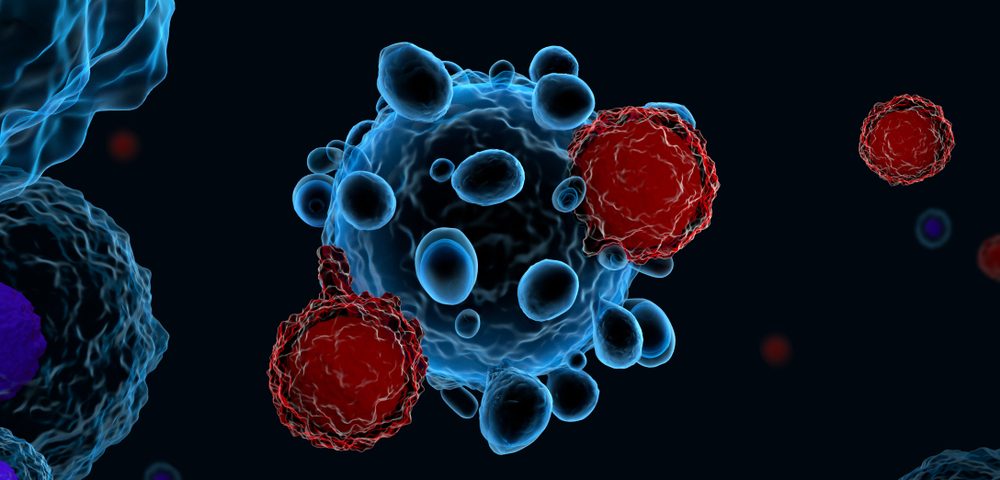FLX475, an investigational anti-cancer therapy by RAPT Therapeutics, is safe and shows promising anti-tumor clinical activity, both alone and in combination with Keytruda (pembrolizumab), in certain types of cancer.
These are the preliminary findings of a global, open-label Phase 1/2 trial (NCT03674567), which is recruiting participants across 32 sites in the U.S., Australia, and Asia.
“We are pleased with the early evidence of clinical activity of FLX475, both as monotherapy and in combination with pembrolizumab in multiple charged tumor types,” Brian Wong, MD, PhD, president and CEO of RAPT, said in a press release.
FLX475 is a new small molecule antagonist of the C-C chemokine receptor 4 (CCR4), a chemokine receptor found on the surface of certain types of immune cells. Chemokines are molecules that help guide immune cells toward specific locations.
The experimental therapy is specifically designed to prevent regulatory T-cells (Tregs) — a subset of anti-inflammatory immune T-cells that dampen the activity of other immune cell subsets — from migrating into tumors.
Importantly, the therapy does not reduce the number of Tregs, nor prevent them from migrating into healthy tissues, which is thought to lower the incidence of potential treatment side effects.
Due to this mechanism of action, FLX475 is expected to be particularly effective against “charged” tumors, defined as those containing high levels of the chemokines that normally interact with CCR4, along with a high number of Tregs and cancer-killing T-cells.
FLX475 also is expected to increase the effectiveness of other cancer immunotherapies, including checkpoint inhibitors like Keytruda that work by boosting the body’s anti-tumor immune response.
The therapy is being developed for potential use across a wide range of cancers, including lymphoma and head and neck cancers.
The safety and preliminary anti-tumor activity of FLX475, alone and in combination with Keytruda, are being investigated in a group of patients with different types of charged tumors participating in the Phase 1/2 trial.
The study is divided into two parts. The first, dose-escalation phase aims to evaluate the safety and pharmacological properties of FLX475, both as a standalone therapy and as part of a combination therapy, alongside Keytruda.
The second, expansion phase is designed to assess the therapy’s preliminary anti-cancer activity in groups of patients with specific types of charged tumors. Changes in the tumor microenvironment and other disease biomarkers are being assessed in both phases.
The Phase 1 portion of the trial enrolled a total of 37 patients. Among them, 19 were assigned to receive one of four daily doses of FLX475 tablets — 25, 50, 75, or 100 mg — and the remaining 18 received one of three daily doses of FLX475, either 50, 75, or 100 mg, in combination with Keytruda.
A total of 14 of the 17 patients who received FLX475 alone and were eligible for response analyses achieved a state of disease control, meaning their cancer either stabilized or was partially or completely eliminated. One patient with metastatic cervical cancer showed an unconfirmed partial response.
With the exception of one patient, all 14 participants who received the combination therapy and were eligible for response analyses achieved the same outcome. One patient with non-small cell lung cancer and another with bladder cancer attained confirmed partial responses.
Preliminary data from this part of the trial also showed the ratio of killing T-cells to Tregs increased following treatment, which was in agreement with FLX475’s mechanism of action.
The findings also showed that FLX475 had a favorable safety profile. While the therapy’s maximum tolerated dose was not reached, two dose-limiting toxicity events were observed in the group of patients who received FLX475 as a standalone therapy.
Based on this data, investigators selected the 100 mg dose as the recommended dose of FLX475 to be used in the study’s second expansion phase, which is now underway.
RAPT is planning to enroll at least 80 patients in this phase, which will be divided into eight groups of 10 participants each. Four of these patient groups will receive FLX475 alone and the other four will be given the therapy in combination with Keytruda.
Enrolled patients will include those with Epstein-Barr Virus (EBV)- or Human Papillomavirus (HPV)-associated cancers, such as nasopharyngeal and cervical cancer, as well as those with different types of lymphomas, and head and neck cancers.
Early data from this phase showed that one of the two patients with EBV-associated lymphoma treated with FLX475 alone achieved a durable complete response.
Moreover, seven out of the 10 patients with nasopharyngeal cancer treated with FLX475 alone achieved stable disease. From these, all five who had never been treated with checkpoint inhibitors and were then switched to receive the combination of FLX475 and Keytruda saw their tumors shrink, with three attaining partial responses.
A state of stable disease also was observed in half of the patients (five of 10) with head and neck cancers who received FLX475 alone. Additionally, two of the six patients who then switched over to the combination therapy achieved partial responses.
Significant tumor reductions also were seen in four of the 10 eligible patients with head and neck cancers who are part of another combination therapy patient group.
As in the previous phase, FLX475 was found to be safe and well-tolerated in all patient groups, both alone and in combination with Keytruda.
Based on these results, RAPT is now planning to expand the groups assessing FLX475 alone, as well as open new patient groups in which the combination treatment will be tested separately in patients with these three types of charged cancers.
“Based on these encouraging data, we have determined that three cancer indications, EBV+ lymphoma, nasopharyngeal cancer and head and neck cancer, have generated sufficient early evidence of efficacy to advance into expanded Phase 2 evaluation,” Wong said.
“We continue to enroll patients and generate data in this multi-cohort, multi-indication trial and look forward to providing updates on all remaining cohorts and additional go-forward decisions next year,” he added.


